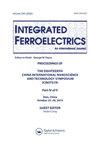(LiNb) 4+取代b位bi0.47 Na 0.47 Ba 0.06 tio3陶瓷的相结构、微观结构和电学性能
IF 0.7
4区 工程技术
Q4 ENGINEERING, ELECTRICAL & ELECTRONIC
引用次数: 0
摘要
摘要由于近年来络合离子取代b位的研究非常有趣,采用固态燃烧法制备了无铅Bi0.47Na0.47Ba0.06Ti1−x(LiNb)xO3 (BNBT1−xLNx)陶瓷(x = 0-0.04)。研究了(LiNb)4+ (x)对合金相结构、显微组织和电性能的影响。所有样品的x射线衍射(XRD)图均显示为纯钙钛矿结构。通过Rietveld精化法分析,所有样品中均观察到菱形相和四方相共存,并且四方相随x的增加而增加。通过扫描电镜(SEM)观察到BNBT1−xLNx陶瓷的形貌,晶粒形状接近圆形,晶粒生长各向异性。当x从0增加到0.04时,密度和平均晶粒尺寸分别从5.84减小到5.54 g/cm3和1.7减小到0.9µm。随着(LiNb)4+含量的增加,晶粒尺寸分布减小。由于(LiNb)4+取代导致的相比改变、微观结构差和密度低,导致介电性能降低。(LiNb)4+取代诱导了从非遍历弛豫到遍历弛豫铁电态的转变。关键词:BNBT1−xlnx相形成微观结构电性铁电性致谢作者感谢河南大学理学院物理系提供的支持设施。感谢Kyle V. Lopin博士助理教授对本文的编辑工作。披露声明作者未报告潜在的利益冲突。本研究由国家科学研究与创新基金(NSRF)通过南京大学(R2565B059)资助。本文章由计算机程序翻译,如有差异,请以英文原文为准。
Phase Structure, Microstructure, and Electrical Properties of Bi 0.47 Na 0.47 Ba 0.06 TiO 3 Ceramics with (LiNb) 4+ Substituted into B-Sites
AbstractDue to the substitution of complex ions into B-sites is very interesting in recent, lead-free Bi0.47Na0.47Ba0.06Ti1−x(LiNb)xO3 (BNBT1−xLNx) ceramics (with x = 0–0.04) were fabricated by the solid-state combustion method. The influence of (LiNb)4+ (x) on the phase structure, microstructure, and electrical properties was investigated. The X-ray diffraction (XRD) patterns exhibited a pure perovskite structure for all specimens. Coexisting rhombohedral and tetragonal phases were observed in all samples and the tetragonal phase increased with increased x, as analyzed by the Rietveld refinement method. The morphology of the BNBT1−xLNx ceramics, obtained by scanning electron microscopy (SEM), revealed almost-round grain shapes and anisotropic grain growth. The density and average grain sizes decreased from 5.84 to 5.54 g/cm3 and 1.7 to 0.9 µm, respectively, when x increased from 0 to 0.04. The grain size distribution decreased with increased (LiNb)4+ content. A reduction in the dielectric properties was observed, due to the phase ratio changing away from a morphotropic phase boundary (MPB), an inferior microstructure, and low density caused by (LiNb)4+ substitution. The (LiNb)4+ substitution induced the transition from non-ergodic relaxor to ergodic relaxor ferroelectric state.Keywords: BNBT1−xLNxphase formationmicrostructuredielectricferroelectric AcknowledgmentsThe authors thank the Department of Physics, Faculty of Science, Naresuan University for their supporting facilities. Thanks, are also given to Asst. Prof. Dr. Kyle V. Lopin for his help in editing the manuscript.Disclosure StatementNo potential conflict of interest was reported by the author(s).Additional informationFundingThis work was supported by The National Science, Research and Innovation Fund (NSRF) through Naresuan University (R2565B059).
求助全文
通过发布文献求助,成功后即可免费获取论文全文。
去求助
来源期刊

Integrated Ferroelectrics
工程技术-工程:电子与电气
CiteScore
1.40
自引率
0.00%
发文量
179
审稿时长
3 months
期刊介绍:
Integrated Ferroelectrics provides an international, interdisciplinary forum for electronic engineers and physicists as well as process and systems engineers, ceramicists, and chemists who are involved in research, design, development, manufacturing and utilization of integrated ferroelectric devices. Such devices unite ferroelectric films and semiconductor integrated circuit chips. The result is a new family of electronic devices, which combine the unique nonvolatile memory, pyroelectric, piezoelectric, photorefractive, radiation-hard, acoustic and/or dielectric properties of ferroelectric materials with the dynamic memory, logic and/or amplification properties and miniaturization and low-cost advantages of semiconductor i.c. technology.
 求助内容:
求助内容: 应助结果提醒方式:
应助结果提醒方式:


